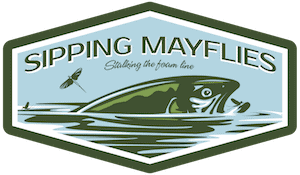Fly Fishing For Rainbow Trout
November 25th, 2022
Rainbow trout are, perhaps, the most iconic species in fly fishing. They’re beautiful fish, incredible fighters, and are found in every single U.S. state.
Chances are you have rainbow trout within reasonable driving distance of where you are at this very moment. There are also many subspecies you can target with your fly rod as well.
Rainbow trout (Oncorhynchus mykiss) are, in my opinion, the ultimate fly fishing quarry, for reasons I’ll detail below.
I’ve caught thousands of rainbows on flies, in many different types of water, using various methods. In this article I’ll share with you my techniques and strategies, the flies that have produced the best for me, as well as pictures and videos I’ve taken.
Where to Find Rainbow Trout
Rainbow Fly Fishing Tactics
What Do Rainbows Eat?
The Best Fly Patterns
Effective Dry Flies
The Best Nymphs
Productive Streamers
When to Target Rainbows
Rainbow Trout vs Steelhead
Rainbow Trout Size
Wild vs Stocked Rainbows
Can Stocked Trout be Wild?
Recommended Gear
Summary
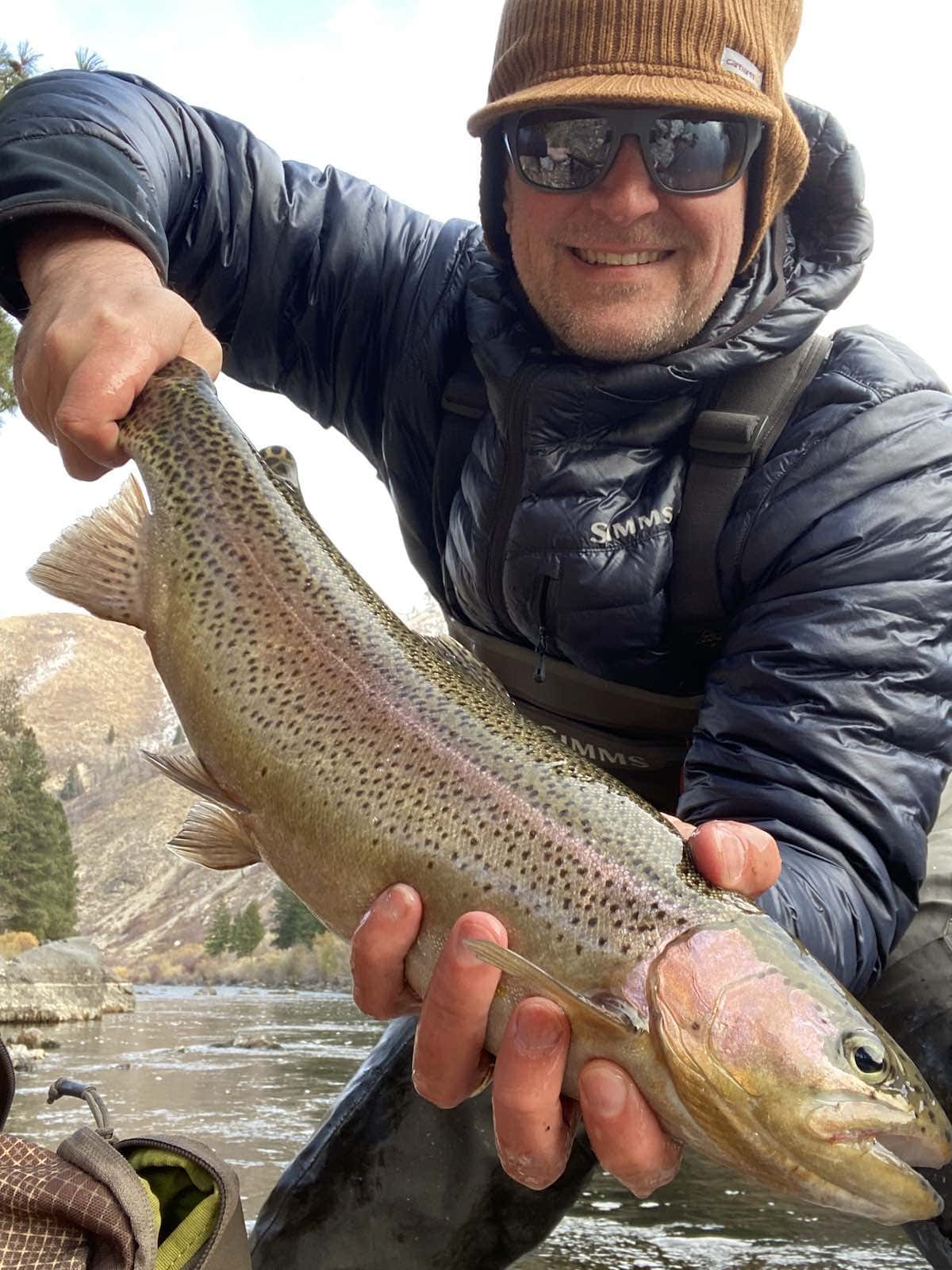
Here’s a fat rainbow trout I caught on a dry fly in early November. Notice the dusting of snow on the hills. The water temperature was around 46F (8C).
Where to Find Rainbow Trout
Rainbows are the most prolific trout in the United States. They can be found in every single U.S. state–yes, even in Hawaii.
Certain states are considered prime, based on their numbers of trout-per-river-mile, including Montana, Idaho, Colorado, Oregon, Wyoming, California, and Utah. But, you certainly don’t have to travel out west to experience exciting rainbow trout angling.
Wisconsin, Michigan, Ohio, Tennessee, Pennsylvania, New York (and many other states) have rivers, streams, and creeks chalked full of trout.
Rainbows can be found in over 46 countries and on all continents except Antarctica.
In fact, rainbow trout are considered one of the world’s top-1o0 most invasive species.
Here’s a USGS (United States Geological Survey) range map showing the estimated distribution of rainbow trout throughout the United States.
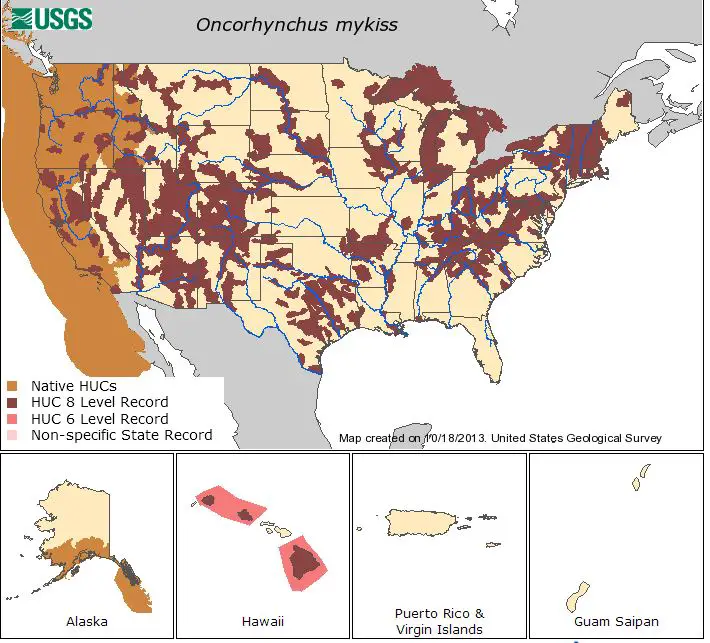
There are several subspecies of rainbow trout, including redband, coastal, Kern river, golden, kamloops, Kamchatkan, as well as others. Sometimes these subspecies look entirely different than a standard rainbow, and other times the differences are minimal. For example, in my experience, it’s not always easy to distinguish between a redband and a pure rainbow.
You’re going to want to focus your exploration on cold water rivers, lakes, and streams. Rainbow trout aren’t a warmwater species, and you’re not going to find them in bodies of water that exceed 75F-80F for long periods of time.
It’s worth mentioning that rainbows can only reproduce in moving water–not in lakes, reservoirs, or ponds (ie. stillwater). Brook trout can, but rainbows and browns can’t.
Now, this doesn’t mean rainbows can’t survive and grow in stillwater. In fact, they can grow to huge sizes in lakes and reservoirs. But, they won’t be able to propagate themselves unless there are tributaries running into the body of water.
With that said, don’t ever overlook stand-alone (ie. isolated) bodies of water when you’re searching for rainbows. Why? Because state Fish and Wildlife departments often stock rainbows in suitable lakes and reservoirs, specifically for anglers.
Which brings me to my next suggestion.
Make sure you’re checking your state’s Fish and Wildlife (or DNR) website for fish stocking records. Often times, you can look up specific bodies of water to see what species have been stocked, including quantities and dates. You can also often find fish survey records, which is a detailing of what fish were found during electrofishing surveys.
Believe it or not, high altitude (alpine) lakes are usually stocked by airplane and contain hungry trout.
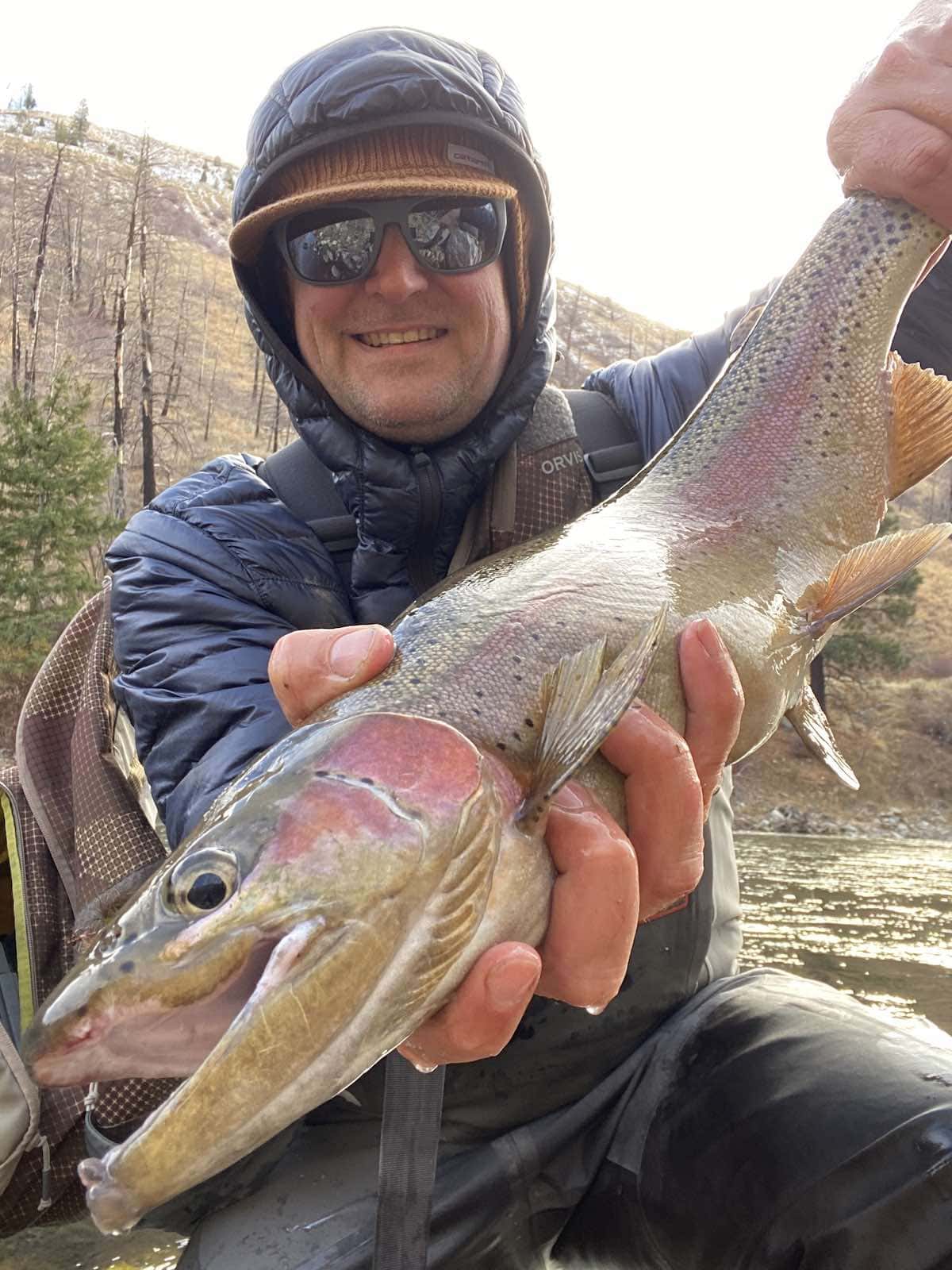
Here’s a mature male rainbow trout I caught on a dry fly on a calm day in mid-November.
Tips on How to Fly Fish for Rainbow Trout
Rainbow trout are ideal fish to target with a fly. The juveniles are nothing short of ravenous and indiscriminate when it comes to feeding, while the sub-adults and adults can often be lured with the right presentation.
Many people think trout are wise. Spoiler alert, they’re not. They’re instinctual.
The bigger trout aren’t smarter, but they do have genetics that naturally make them more easily spooked and alert. They attain a big size because they’re cautious, not because they’re smart. If trout were smart, they’d learn the look and shape of a beadhead nymph, or a barbed hook, and yet they don’t. At least, not for more than a few days.
So, don’t be intimidated by trout. They’re very catchable.
Here are some techniques and tactics that I’ve learned over the years.
Drag-free drift (and mending)
I’m not going to assume my readers are at any particular level of fly fishing knowledge. With that said, you need to make sure you’re achieving a drag-free drift.
This means your fly shouldn’t drag through the water as it floats with the current. It should remain motionless, like a leaf floating on the surface of the river. If your fly is darting back-and-forth, or is creating a wake, you’re not going to catch anything. Trout will almost always reject your fly if they see drag.
Personally, I avoid mending if at all possible. I take this into consideration during my approach and subsequent cast. Why do I avoid mending? Because lifting your line off of, and then back onto, the water can spook fish. Mend only when necessary to avoid drag.
Minimize false casts
Most fly anglers place much too much focus on repeated false casts.
Guess what? False casts spook fish.
I only false cast when it’s absolutely necessary, or to dry my fly. And when I do, it’s off to the side, not over the fish I’m casting towards.
Fly fishing clothes
Avoid wearing bright colors when you’re fly fishing. I’m not going to get into how trout view the world, you can research that separately, but suffice it to say, trout can see you more often than you think.
Bright colored clothing (including hats) stands out abruptly from your surroundings, and brings you unwanted attention. You stand out like a sore thumb to trout (and most fish species).
Wear clothing that blends into the background of wherever you’re fishing.
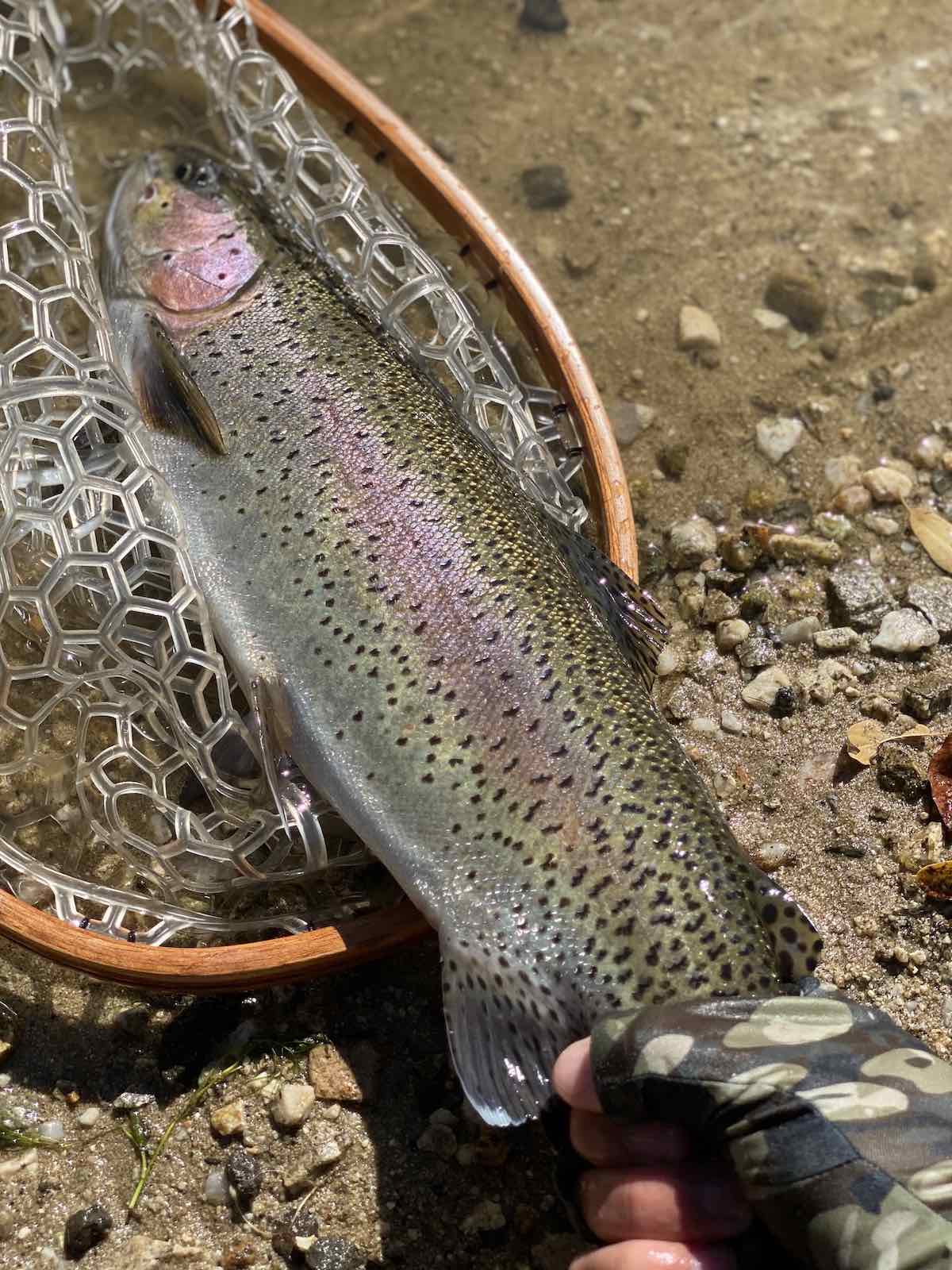
In the above picture you can see a rainbow trout I caught in a pool section of a local river. It was 5-7 feet deep with a slow current, during a PMD (Pale Morning Dun) hatch. The net hoop length is 18-inches.
Fishing in Pools
In the above picture you can see a rainbow trout I caught in a pool section of a local river. It was 5-7 feet deep with a slow current, during a PMD (Pale Morning Dun) hatch.
Pools are essentially deeper sections of a river, where the current slows. Sometimes it looks as if there isn’t any current at all, but there always is, even if it’s imperceptible.
If you’re into streamers (more on that below), pools are going to be your focus. This is where plenty of big fish hold, and most trout become more and more piscivorous as they mature, so streamers can coax them out of hiding.
If you’re into dry flies, like I am, pools can be the most challenging of the various types of water, but productive nonetheless. This is because pools often have glassy surfaces, and they’re slow, meaning the fish have all the time in the world to analyze your fly pattern. I like the challenge.
This is in contrast to a quick riffle or pocket water, where the fish must often make split-second decisions regarding whether to eat your fly or not.
In summary, pools are deeper and slower sections of a river where the rainbow trout will generally be larger in size, and more apt to chase a streamer.
Riffles and Pocket Water
Riffles are the lifeblood of any river, since they contain so much insect activity and are highly oxygenated.
These areas of a river are always shallow and rocky, with a turbulent surface. The turbulence on the surface of the water is due to the currents caused by water rushing through and across rocks.
Rainbows in riffles tend to hold in one spot, which is nice if you’re stalking rising fish. This is in contrast to a pool where they often move around freely.
Dry flies and nymphs work well in riffles, or better yet a dry-dropper setup.
If you want to learn more, I wrote two articles you may want to read: how to fly fish in riffles and how to fly fish in pocket water.
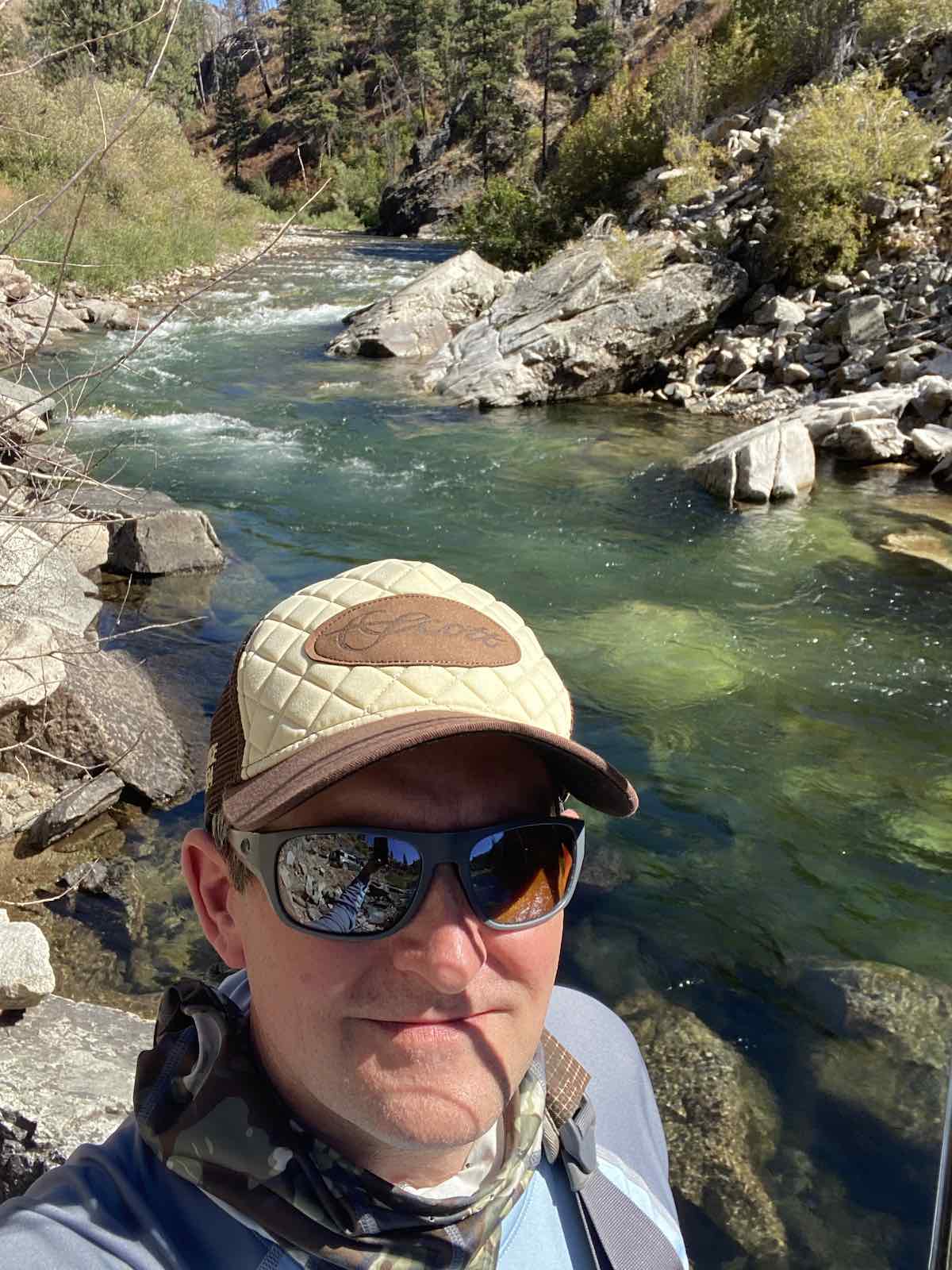
Here’s some prime rainbow trout habitat. I caught quite a few on dry flies along this short stretch of water, which was comprised of both pool and pocket water areas. Notice the shallow riffle feeding into this section from above.
Undercut or overhanging banks
Whenever you’re wading in a river and notice an undercut or overhanging bank on the shoreline, start planning your cast. These are spots where the current has carved-out an underwater indentation along the bank.
These are absolutely prime spots where big rainbow trout hold. The reason they hold in these spots is because the current is slower and they don’t need to expend as many calories hunting for prey items such as nymphs, terrestrial insects, or minnows.
The trout can simply dart-out of their holding spot, grab their prey, and return to their undercut lie.
Big fish often hold right near the shoreline, so don’t overlook these types of areas.
Overhanging trees and brush
Rainbow trout appreciate the protective cover that overhanging trees and brush provide. Not only that, plenty of terrestrial insects such as ants, beetles, and grasshoppers fall from the branches into the water, where they’re promptly eaten by the fish.
Trees and brush also provide shade, which is another bonus.
The bottom-line is, strategically casting your fly so that it drifts underneath overhanging vegetation often pays off in a big way.
The risk is that you’re going to get tangled-up in the branches, and trust me, it’ll happen. But, it’s a risk worth taking every single time.
Fishing stillwater
It’s going to sound like I’m contradicting myself, but when you’re fly fishing for rainbow trout in stillwater, such as a lake, reservoir, or pond, you usually want to give your fly a little action.
In a lake, for example, giving your dry fly a little action makes it look like a bug struggling on the surface of the water. This movement can, in fact, work on rivers too, but that’s another story.
If you’re casting streamers for rainbows in stillwater, focus on areas that have a steep drop-off. Fish hold in these spots, and often times they’re good-sized.
Stillwater can get windy, especially alpine lakes, so it’s an important factor to understand.
If the wind is coming from the north, for example, you know that the north shore will have the calmest water due to trees diffusing the wind.
In this same scenario, you also know that the wind will be blowing flotsam and insects to the south shore, where rainbows will likely be picking off the bugs.
What do Rainbow Trout Eat?
If you’re fly fishing for rainbow trout, you’ll always want to pay attention to what the fish are currently eating. It can change from day to day. This is generally referred to as “matching the hatch.”
When you get to the river or lake, just watch the water. Is there a hatch going off? Are they mayflies like PMDs or Blue-winged olives?
What size are the bugs? What color are they?
These are all important questions to ask if you want to understand what the trout are eating.
Rainbows aren’t as piscivorous as brown trout, but they still eat plenty of fish. Their diet is instead mostly comprised of insects such as mayflies, stoneflies, caddisflies, cicadas, beetles, ants, grasshoppers, and various aquatic larvae. It really depends upon the time of year.
Larger rainbow trout will still eat tiny insects, but they’ll also consume crayfish, mice, frogs, and fish eggs. I once found a large hellgramite inside the stomach of a rainbow I was fileting.
Steelhead living in the ocean eat primarily squid and other fish. I’ll explain more about steelhead shortly.
If you’re interested in learning more about brown trout, check out my article about how to fly fish for brown trout.
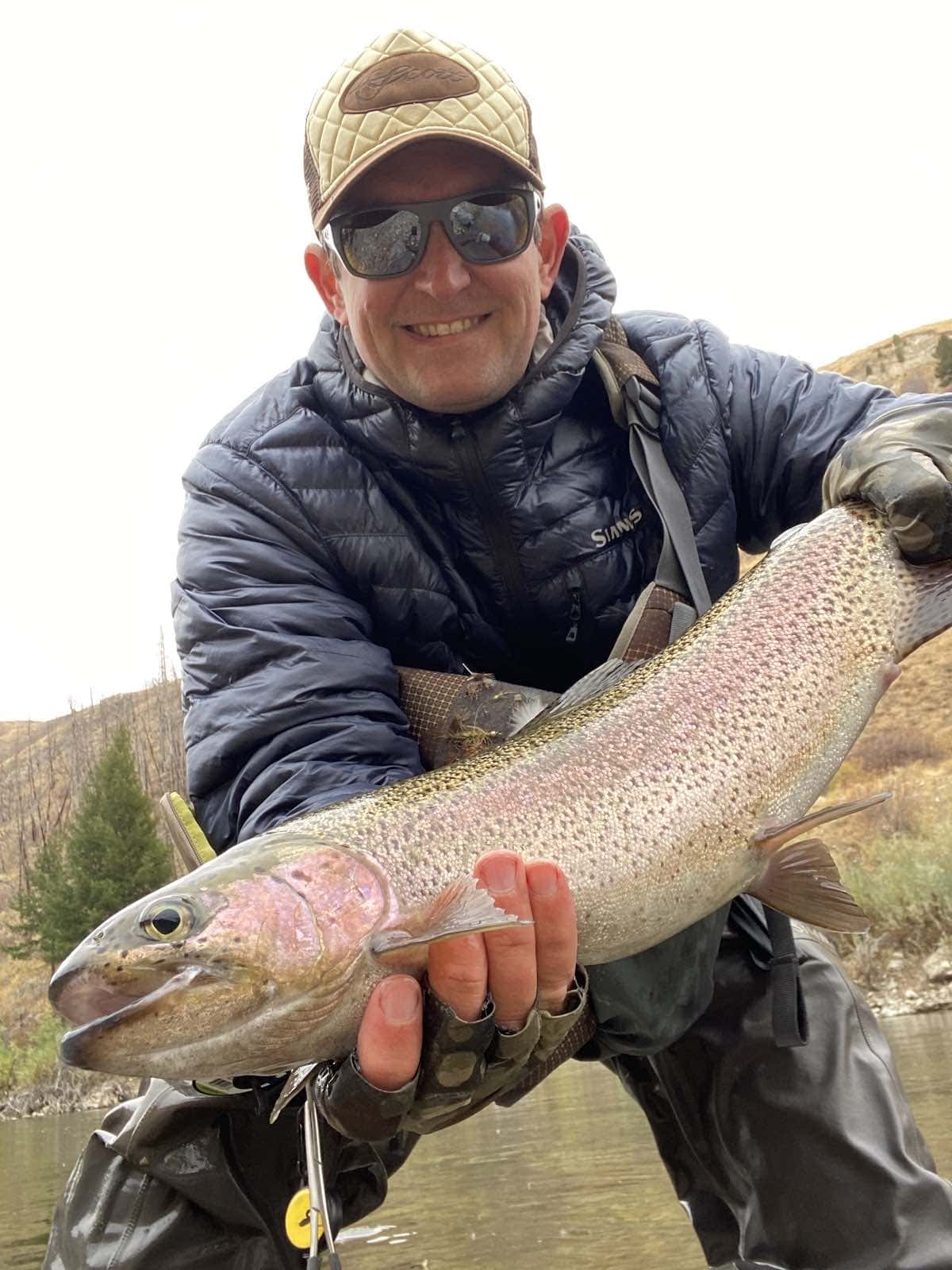
The Best Flies for Rainbow Trout
I’ve fished plenty of fly patterns over the years and, as you can imagine, certain patterns stood above the rest.
Small rainbow trout are, as I mentioned, easy to fool. They’ll eat just about any fly pattern that they can fit into their mouths.
Bigger rainbows are another story–they can be much more picky. In fact, you better bring your A-game.
In this section I’ll unveil the most productive fly patterns I’ve personally used to catch finicky rainbow trout. While I’m primarily a dry fly fisherman, I’ve caught plenty of rainbows using each method–dries, nymphs, streamers, and wet flies.
Dry Flies for Rainbow Trout
Dry fly fishing is exciting because you have a connection with the fish at the surface. You hunt for rises, you stalk a particular fish, and you get to watch the take.
Here are a few dry flies that are consistent producers for me, and they will be for you too.
BWO (Blue Winged Olive)
Blue-winged olives are prolific mayflies that hatch year-round. They become the main focus all winter long because only two bugs are regularly hatching during the cold season: BWOs and midges.
You’re going to want to match the size of the BWOs on the water, but you’ll usually want to be using sizes in the range of 18-22.
There are a number of different BWO pattern variations, such as parachute, CDC, biot, etc.
Check out my article about fly fishing with BWOs.
PMD (Pale Morning Dun)
PMDs are yellow mayflies that are always easy to spot on the water due to their unique coloration. They’re usually a little bigger than BWOs, and rainbows relish sipping them at the surface.
These mayflies are usually only on the water during the summer and fall, so use this fly accordingly.
You’ll want to use a PMD in 16-20 size range.
Elk Hair Caddis
This fly isn’t just effective on rainbow trout, it’s a pattern you should always have available for your fly box. It’s a classic for a reason.
The elk hair caddis fly can imitate a bunch of different insects, including moths, grasshoppers, spiders, caddisflies, spiders, and more. It’s an extremely versatile pattern that’s usually most effective during the summer and fall seasons.
I’ve caught 40+ rainbows in a day using this fly alone. In my experience, the bigger the better. I usually use this fly in sizes 10-14. You’ll be surprised at how aggressive juvenile rainbow trout can be towards this fly.
You can get this exact pattern on this page at Amazon.
Chernobyl Ant
The chernobyl ant is a hopper pattern. That is to say, it’s tied to mimic large terrestrial insects.
One of the best things about this fly is that, due to its foam body, it’ll float forever (ie. it won’t drown) and you don’t need to apply any floatant. If you’re unfamiliar, read my article on the best fly floatant.
Giving this fly a little movement can trigger a strike. It has for me many times.
This fly pattern should be used during hopper season, which is essentially summer and early fall. You can get a nice selection of this pattern on this page at Amazon.
Honorable mention: Royal Humpy, Adams
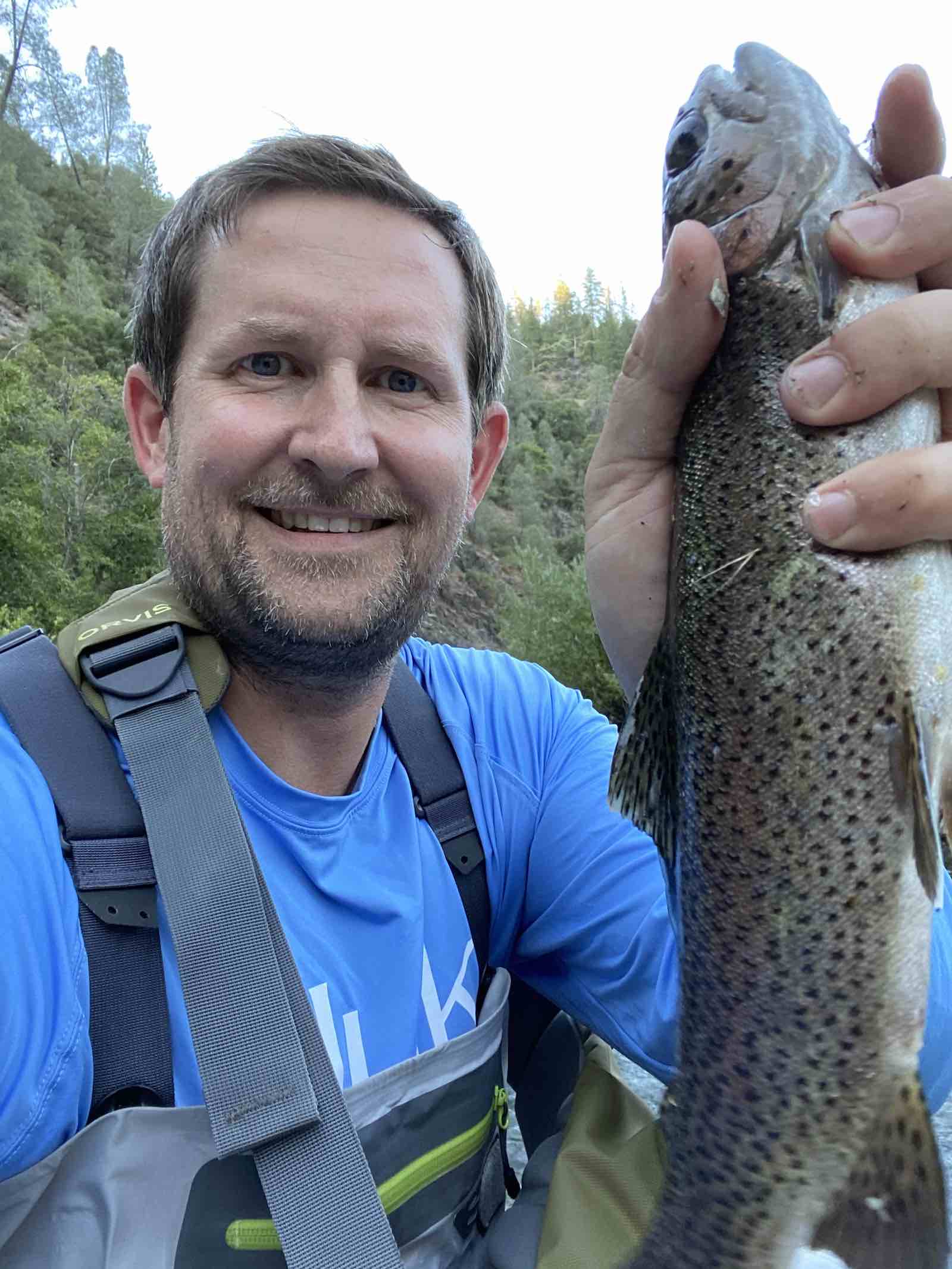
Here’s a feisty rainbow trout I caught in July on a chernobyl ant fly pattern on the middle fork of the American river.
Nymphs for Rainbow Trout
Nymphing is undoubtedly the most popular way to fly fish for rainbow trout. It’s been said that trout eat subsurface 90% of the time, and while I certainly don’t subscribe to that theory, it’s certainly a high percentage of the time.
While I find drifting nymphs relatively boring, it can be deadly effective. Small and large rainbows alike eat nymphs all day long, all year long.
Here are the most productive nymph patterns I’ve used to catch rainbow trout.
Pheasant tail Nymph
I’m a big believer in the 80/20 rule, otherwise known as Pareto’s Law. It applies to virtually everything around us.
In fly fishing, I firmly believe that 80% of the fish are caught with 20% of existing fly patterns. With that said, the pheasant tail pattern is chief among them.
If you don’t have this nymph in your fly box, go buy it on this page at Amazon. I’m serious. Stop reading, go buy it, then come back.
If I could only have one single nymph for the rest of my life, it’d be a pheasant tail. Specifically, a beadhead.
The beadhead version sinks well, and it means you don’t always need to add weight to your leader. But, the added weight does make it easier for the fish to throw your fly during aerial acrobatics.
In my experience, the most effective sizes for rainbows are 18-22.
Hare’s Ear Nymph
This pattern is super effective on trout. If I ranked a pheasant tail a 10, I’d rank a hare’s ear a solid 8. You really should always have both available.
One productive strategy is a double nymph rig. In this case, I’d initially tie on a hare’s ear, trailed by a pheasant tail. One of the flies could be unweighted. It’s always good to experiment on the water. You’ll learn a tremendous amount.
A rubber leg hare’s ear can be surprisingly deadly.
Honorable mention: Prince nymph
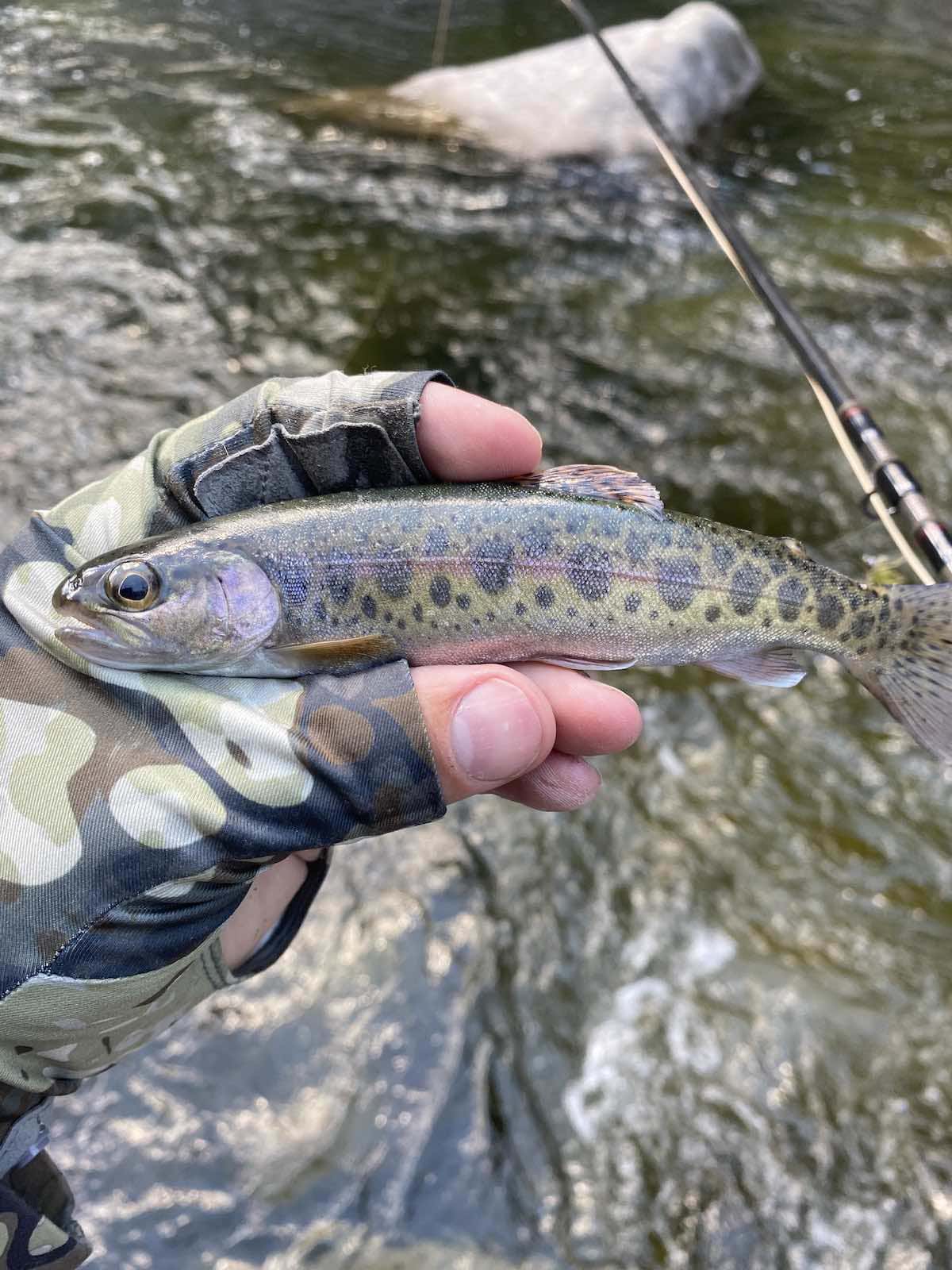
While juvenile rainbow trout aren’t selective feeders (in other words they’re easy to catch), they’re beautiful, and good fighters for their size. Here’s a small one I caught during a productive day on an Idaho river.
Streamers for Rainbow Trout
You can cast streamers year-round for rainbow trout, but my favorite seasons are spring and fall.
One of the beautiful things about tossing meat (aka casting streamers), is that you get to experiment with different retrieves. And, I can tell you, the retrieve often matters.
Sometimes the faster the better, and sometimes erratic and random works best. Sometimes a long strips work better than short strips, and vice-versa.
Woolly bugger
I recall one prominent fly fisherman being asked a common question: “What if you could only use one fly for the rest of your life.”
I’m sure accomplished anglers hate the question, but he didn’t hesitate in responding with, “a woolly bugger.”
Woolly buggers work for just about anything. You can catch carp on a woolly bugger suspended beneath an indicator. I’ve even caught a 5-inch sculpin on one.
To my eye, this pattern resembles a leech. I’m not sure if the fish think it’s a leech, or a minnow, or a hellgramite, or a salamander. It just works.
You should experiment on your home waters with the variations, such as beadhead or non-beadhead, and even rubber legged versions. They come in a variety of colors too, but black is by far the most popular.
Bouncing a weighted orange or red woolly bugger off the bottom definitely resembles a crayfish.
It can be fished so many ways. You can pick up a nice set of these flies on this page at Amazon.
Bunny leech
Rainbow trout love leech patterns, and the bunny leech pattern has caught me a bunch of them.
Like the woolly bugger, the bunny leech fly comes in many different colors, and color matters. There are times when a particular color is bringing fish to the hook, and other colors don’t. There’s a saying worth mentioning: “Dark day, dark fly. Bright day, bright fly.”
You can cast and retrieve the bunny leech, or you can drift it under an indicator. There are weighted, and unweighted, versions of the fly.
Honorable mention: Clouser minnow
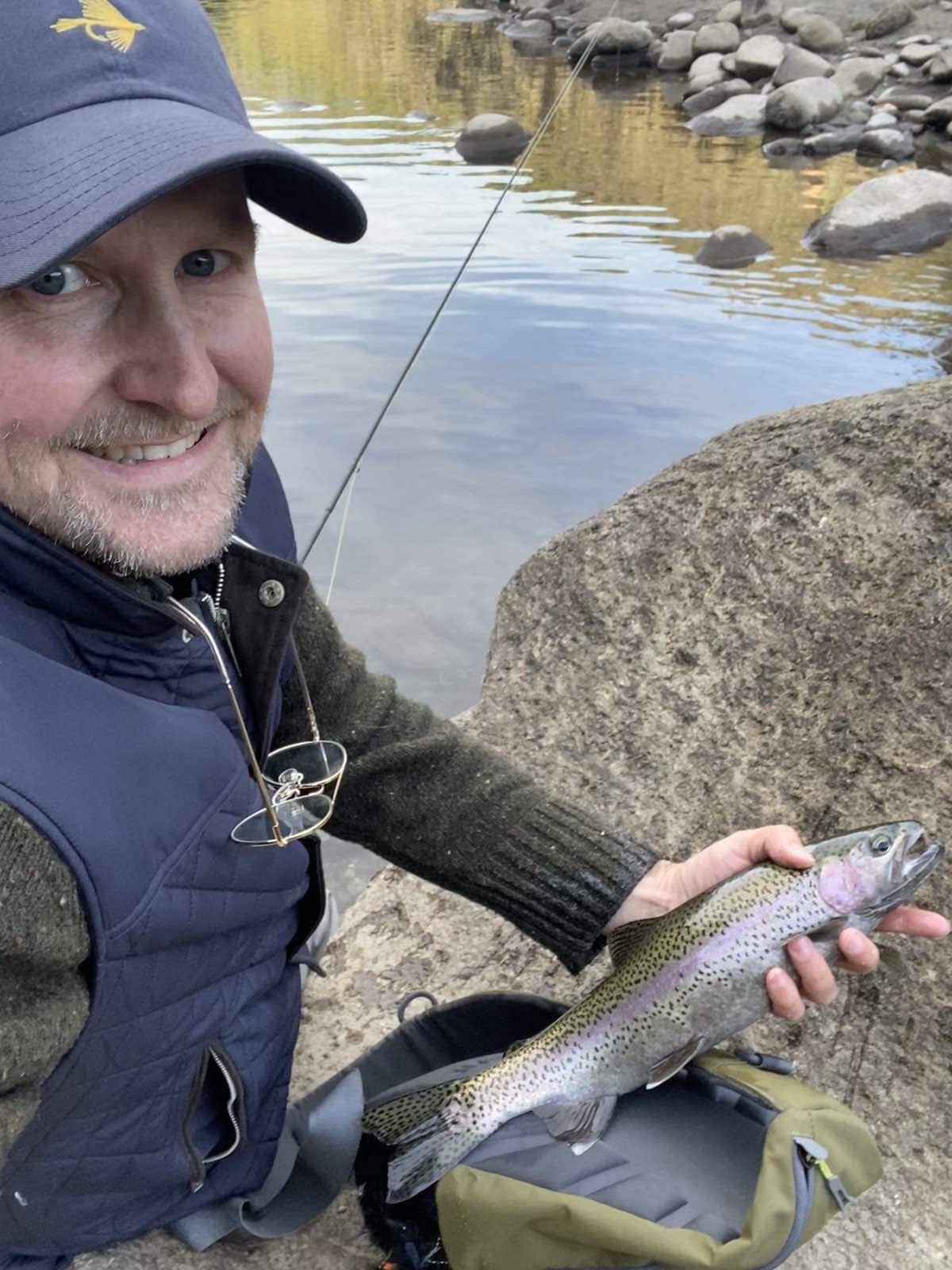
This solid rainbow tore fly line off my reel after I hooked it on a BWO pattern in December.
When to Fly Fish for Rainbow Trout
Winter (January, February, March)
Fly fishing for rainbows can still be productive throughout the winter season. Yes, it gets uncomfortably cold for us humans, and ice in your guides can be frustrating, but I can offer you really helpful advice in my article detailing 46 winter fly fishing tips.
As I mentioned, trout eat year-round. The colder water temperatures do mean they eat less, but they’re still eating. Trout don’t want to chase prey during winter–they want it on their nose. So, most folks drift nymphs.
Hatches are generally less robust, but BWOS and midges are still active.
Spring (April, May, June)
Rainbow trout spawn during the spring. The exact spawning timeframe depends on your geographical location. It may be early spring, mid-spring, or late spring.
Don’t be a richard–leave spawning trout alone.
It’s incredibly shortsighted to target trout that are attempting to produce future generations of fish.
Some states disallow fishing completely during the spawning period, which can be a two-month block of time.
Once the spawn is over, rainbows try to put on weight, which translates to a lot of consumption.
Summer (July, August, September)
Summertime is my favorite season for rainbow trout fly fishing. It’s warm out, hatches are occurring in full force, the days are long, hoppers and other terrestrial insects are active, and the fish are hunting en masse.
Watch for PMDs, baetis, yellow sallies, and caddisflies. Also, keep an eye out for stoneflies–it can be an exciting hatch to fish.
My focus is often on various hopper patterns during the summer.
Fall (October, November, December)
Fall is a close second in terms of my favorite season to chase rainbows. I’m out west in Idaho, so weather may be different where you are, but I like fall’s crisp temperatures, clean air, and active fish.
Terrestrials aren’t as effective once the grasshoppers disappear from the shoreline, but standard dry flies (match the hatch), nymphs, and streamers all work well during fall.
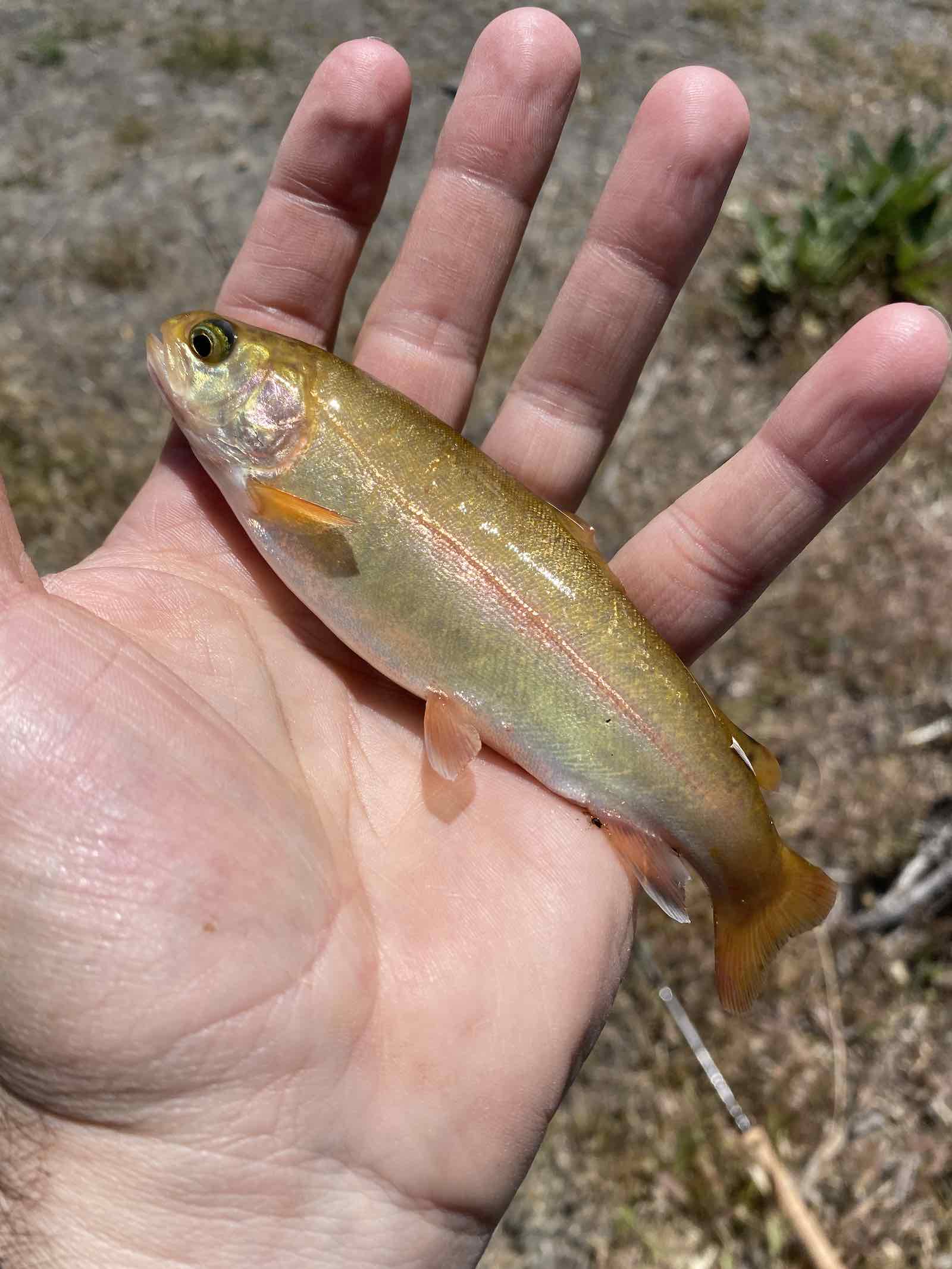
Here’s a golden-colored rainbow trout (Oncorhynchus mykiss) that I caught on a wet fly during the summer. It’s not albino or a separate species, it’s just a rainbow with different coloration.
Rainbow Trout vs Steelhead
All steelhead are rainbow trout, but not all rainbow trout are steelhead. Confused yet?
Steelhead and rainbow trout are genetically the same species, but they live vastly different lives.
Specifically, standard rainbow trout hatch and spend their entire lives in freshwater rivers, lakes and streams.
Steelhead are “anadromous” fish, meaning they’re migratory. They hatch in freshwater rivers, lakes, and streams, where they remain for the first few years of their lives. Then, steelhead migrate to the ocean where they spend around three years chasing squid and fish. They attain a much larger size than your average rainbow trout that spends it’s entire life in freshwater.
Steelhead then return to freshwater where they spawn.
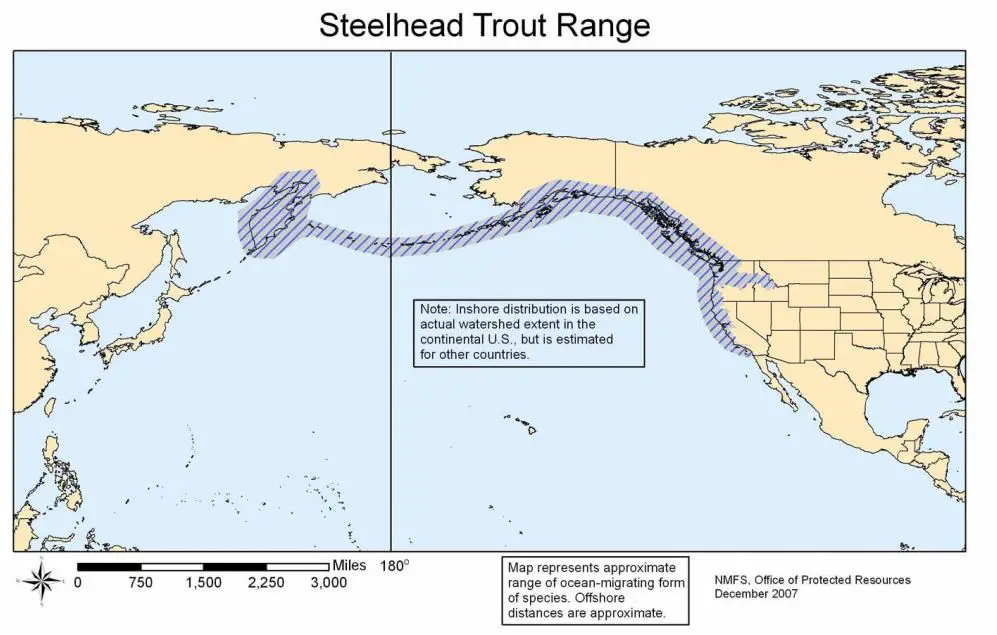
How Big do Rainbow Trout Get?
The world record rainbow trout was 48-inches long and weighed an astounding 42 pounds. It was caught in a lake in the Canadian province of Saskachewan.
This trout was a triploid hatchery fish, which means it was hatched and reared to a certain size at a hatchery, then released into the wild.
If a fish is “triploid,” it simply means it cannot reproduce. This is an intentional genetic adjustment made at the hatchery. Triploid fish don’t need to develop reproductive organs or eggs, and all their energy goes into growing. This means they often attain ridiculous sizes, especially their girth.
Small streams, creeks, and tributaries often hold juvenile rainbow trout in the 5-10 inch range.
Sub-adult and adult rainbows generally move into larger bodies of water to hunt (rivers and lakes), and can attain a length of 20+ inches and a weight of 5+ pounds within 4-6 years.
Lake-dwelling rainbows are usually the biggest you’ll come across, but not always.
Wild vs Stocked Rainbow Trout
Wild trout are trout that hatched in the wild from eggs laid by parents that also hatched in the wild.
Farmed (ie. stocked) rainbow trout are fish that developed from eggs that were fertilized in vitro at a hatchery. These farmed trout are raised to a certain size, usually a few inches, and then released into the wild.
Rainbow trout were first commercially farmed in San Francisco in 1870. The resultant fish were shipped all over the nation to be planted into rivers, lakes, and streams.
These released fish are termed “stocked” trout. They don’t act like wild trout, because they were raised in cement containers surrounded by tens of thousands of other rainbows, and fed pellets exclusively.
Farmed or stocked trout don’t act live native or wild rainbows, and often throw a monkeywrench into the natural order of things, so-to-speak. They don’t understand hierarchies or correct social behavior, they can carry whirling disease, and they’re more apt to hybridize with other species such as cutthroat trout.
Rainbow trout that hybridize with cutthroat trout are called “cutbows.”
If you want to have your eyes opened to the realities of farmed trout, I highly recommend you read An Entirely Synthetic Fish by Anders Halverson. The subtitle is, “How Rainbow Trout Beguiled America and Overran the World.”
I found it to be a fascinating read.
Anyhow, farmed/stocked rainbow trout are widely considered easier to fool with a fly when compared to their wild counterparts. Fly fishers always prefer chasing wild trout. There’s something less special about casting to farmed fish.
If you catch a small rainbow with roughed-up fins, it’s likely a stocked fish. Their fins get worn-down in the cement containers they’re raised in.
Here’s a picture of a beautiful wild rainbow trout I caught on a dry fly in one of my favorite rivers in northern California.
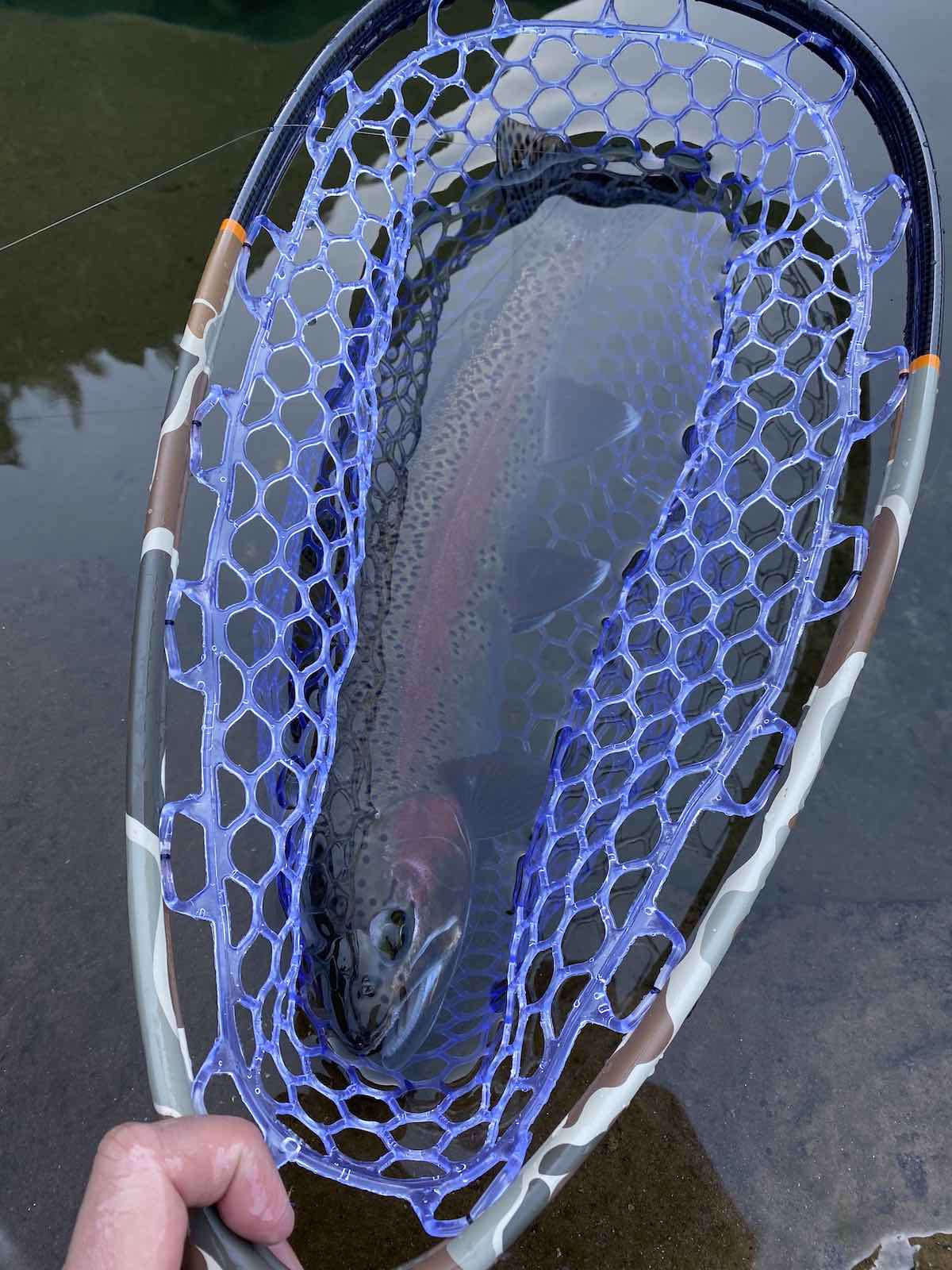
Can Stocked Trout Become Wild?
At a certain point, a population of stocked rainbow trout can indeed become considered “wild.” In fact, the native range of rainbow trout is a fairly tight band along the west coast of North America, from Alaska down through British Colombia, Washington, Idaho, Montana, Oregon, California, and even northern Mexico.
So, most rainbow trout throughout the rest of the United States are descendants of stocked hatchery-bred fish that were planted over time.
Generally speaking, the point at which stocked rainbow trout become “wild” is three generations.
Recommended Rainbow Trout Fly Gear
Fly Rod
You’re going to want a 4 or 5-weight fly rod for medium-to-large rainbow trout. Personally, I use a 5-weight because it helps me land the fish a little quicker. The sooner you can land your fish, the better its chances of survival.
Also, if you’re going to cast small streamers, a 5-weight is better than a 4-weight because it’s stronger, and will allow you to cut through the wind a little easier.
If I’m fly fishing in a small stream or creek for rainbows, I like to use a 7.5-foot 3-weight rod.
Length-wise, I’d recommend a 9-foot rod if you’re casting dry flies or streamers in larger bodies of water. If you’ll primarily be nymphing, a 10-foot rod is advantagous.
If you want a dedicated streamer rod for rainbows, get yourself a 7-weight rod. It’s added strength will make casting streamers much more pleasant, especially in the wind.
But, the best all-around rainbow trout fly rod is a 9-foot 5-weight. Period.
Fly Reel
All small and medium-sized trout can simply be stripped-in, meaning you don’t use your reel. In situations where you get into more mature fish, you’ll want a dependable reel with a drag system that’s easy to adjust.
Sage, Bauer, Orvis, Abel, Hardy, and several others are all reliable reel companies.
Most fly reels can be adjusted easily for left or right-handed retrieval.
Fly Line
If you’re a dry fly or nymphing aficionado, get yourself a weight-forward floating line to match the weight of your rod. For example, if you have a 5-weight fly rod, get a 5-weight fly line.
If you’re going to focus on streamers, I’d recommend a sink-tip line, or a full sinking line.
A full sinking line will begin sinking as soon as it hits the water. The rate at which it’ll sink is known as its IPS (Incher Per Second) rating.
A sink tip line is a standard weight-forward floating line, but the last 10-20 feet of line will sink. So, the tip of the line sinks, thus the name.
But, don’t ever use a sink-tip or full sinking line if you’re casting dry flies or drifting nymphs. You don’t want your line to sink in these scenarios.
Leader & Tippet
Rainbow trout can be leader shy, unlike largemouth bass or panfish. This means they can spook or false take if your leader is too apparent.
If you are casting flies that are size 10-14, I’d recommend you use 4X leader and tippet.
Flies that are sized 16-18, I’d use 5X leader and tippet.
Finally, if you’re casting small flies sized 20-26, I highly recommend using 6X.
Don’t waste your time with 7X.
If you’re nymphing or casting streamers, buy some fluorocarbon leader and tippet. It’s less visible and stronger than monofilament, and it’ll sink. But, if you’re dry fly fishing, use monofilament instead.
If you’re casting dry flies, I recommend a 10-16 foot leader/tippet. This means the cumulative length of the leader plus the tippet is 10-16 feet.
If you’re casting streamers, a leader/tippet length of 5-6 feet is just fine.
When you’re nymphing, it’ll just depend on how deep you want your nymphs to drift.
General Gear
A great slingpack or backpack is an invaluable piece of equipment for any angler. If you’re curious, don’t miss my article on the best fly fishing slingpack I’ve ever used (and I’ve used quite a few).
A good pair of forceps or hemostats is mandatory. If you don’t already have some, I published an article detailing the best fly fishing forceps and how to use them.
The reason this is a vital tool is because you need to be able to remove your flies from a trout’s mouth quickly. Sometimes it’s not easy to remove a size-20 fly lodged deep in a trout’s mouth, and that’s when forceps come in handy.
Crushing your hook’s barb (also done with forceps) will make removing flies much faster.
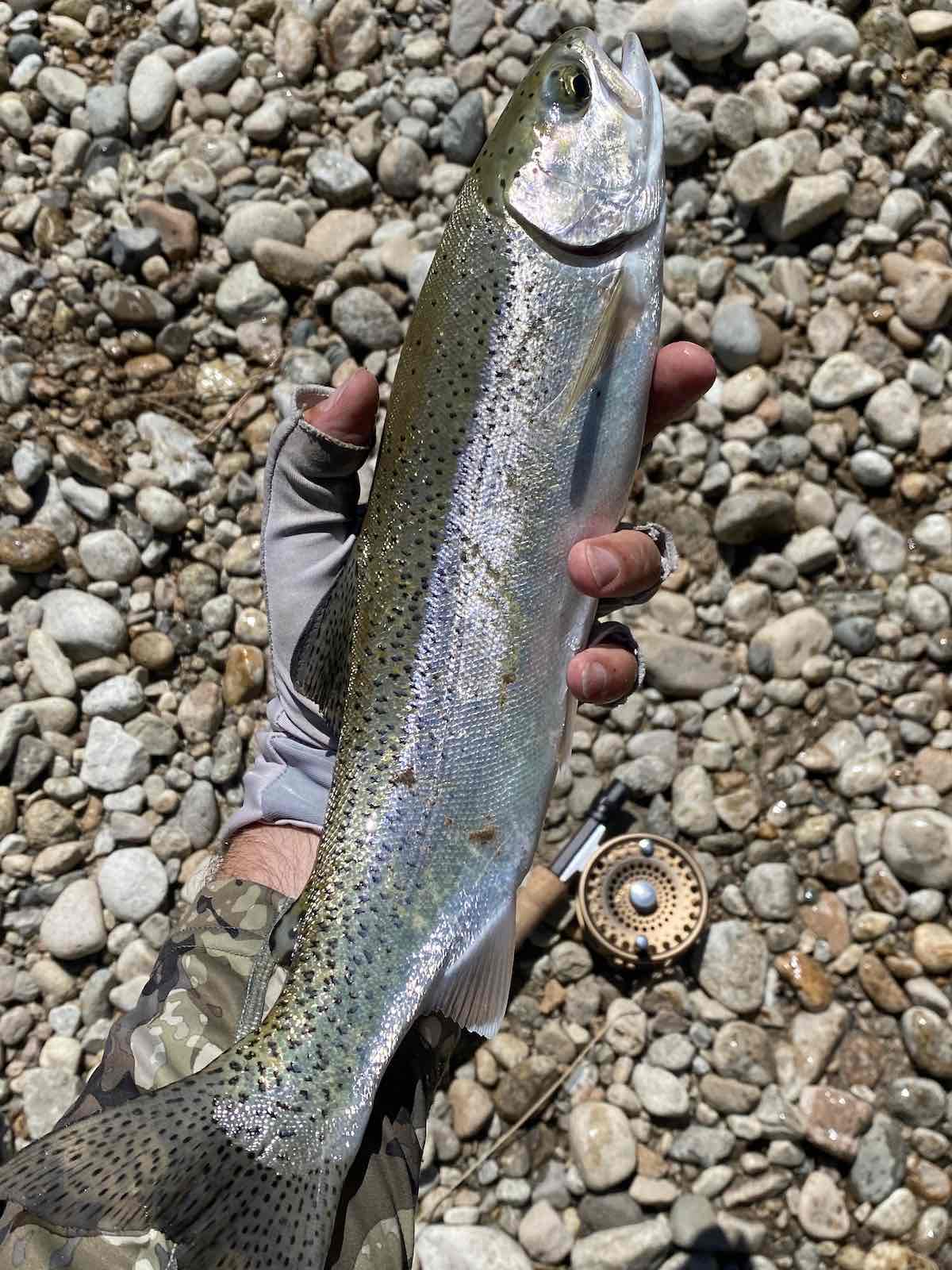
This acrobatic rainbow trout took my caddisfly pattern on a hot summer day up in the mountains. It was in a river not more than 20-feet across and, while not a huge fish, it tore off a decent amount of line during its initial run. Fly fishing for rainbow trout is exciting!
Summary
Rainbow trout are strong fish–they definitely put up a stronger fight than brown trout, all other things equal. Their aerial acrobatics and long freight-train runs make landing them an adrenaline rush. They’re prime quarry for any fly angler.
These fish will challenge you–the large ones aren’t easy to fool. You must avoid spooking them, maintain a drag-free drift, choose the correct fly, and maintain control during the ensuing fight.
Now get out there and hook some fish!
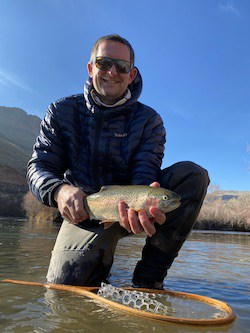
About the Author
My name's Sam and I'm a fly fishing enthusiast just like you. I get out onto the water 80+ times each year, whether it's blazing hot or snow is falling. I enjoy chasing everything from brown trout to snook, and exploring new waters is something I savor. My goal is to discover something new each time I hit the water. Along those lines, I record everything I learn in my fly fishing journal so I can share it with you.
Follow me on Instagram , YouTube, and Facebook to see pictures and videos of my catches and other fishing adventures!
